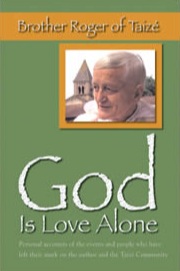 The perfectly bizarre story of Brother Roger's murder at Taizé, the religious community he founded in 1940, has caused a humble ripple today on the Godbeat. Most of the stories are competent summaries of Brother Roger's life and ministry.
So far, though, the most moving reflection on Brother Roger comes from Ruth Gledhill of the Times of London. The piece's headline, "Murdered Taizé leader was new age pioneer," speaks more to his musical than to his theological influence.
The perfectly bizarre story of Brother Roger's murder at Taizé, the religious community he founded in 1940, has caused a humble ripple today on the Godbeat. Most of the stories are competent summaries of Brother Roger's life and ministry.
So far, though, the most moving reflection on Brother Roger comes from Ruth Gledhill of the Times of London. The piece's headline, "Murdered Taizé leader was new age pioneer," speaks more to his musical than to his theological influence.
Gledhill writes:
Given all the current controversies surrounding so many religious leaders, Brother Roger was the last for whom any would have predicted a violent death. His rule, if he had one, was: "Love, and express that with your life."
. . . Music and song are the keys to understanding the Taizé phenomenon. A classically-trained musician, Brother Roger introduced the form of meditative chant that came to characterise Taizé and which has been taken up by churches worldwide.
Many churches today hold regular Taizé services using the community's music, for which Brother Roger never took any personal credit, but which has always born his indelible numinous imprint.
Few are aware of the extent to which the soft, rhythmic harmonic chants of Taizé influenced the development of the new age and ambient genres that have moved into the secular mainstream.
. . . The Taizé songbook states: "Song is one of the most essential elements of worship. Short chants, repeated again and again, give it a meditative character. Using just a few words, they express a basic reality of faith, quickly grasped by the mind."
Christians worldwide will be praying that Brother Roger's death will not silence his song of reconciliation, beauty and peace.
About the art: God Is Love Alone is available from GIA Publications of Chicago.
